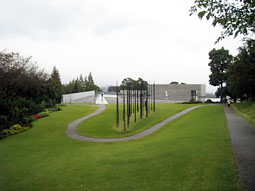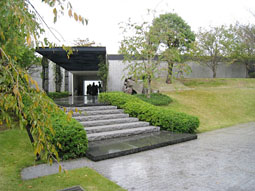 |
|
 |
| The Vangi Sculpture Garden Museum, part of Clematis-no-Oka, Nagaizumi-cho, Shizuoka Prefecture |
|
Izu Photo Museum |
|
|
A conversation overheard recently at the Vangi Sculpture Garden Museum, which gracefully sprawls through terraced gardens in the foothills of Mt. Fuji at Nagaizumi-cho, Shizuoka Prefecture:
Man 1: "What a beautiful museum."
Man 2: "Yes, but it seems a bit of a waste to devote it just to one artist."
Man 1: "Vangi must be a happy guy -- look, that whole pond is given over to a single sculpture."
Not wanting to begrudge the 78-year-old Italian sculptor Giuliano Vangi his happiness, but I couldn't help agreeing with the second guy.
If the truth be known, since 2005 the Vangi Museum has set aside one of its galleries for young Japanese artists, but unless you were at least partly interested in the artist for whom the place is named, it was never going to be easy to justify the hour-long Shinkansen trip from Tokyo. Now, there's another reason to go -- and it's utterly compelling.
The Vangi Museum actually forms the core of a complex known as Clematis-no-Oka, or Clematis Hill, and on October 26 it opened a new facility within its grounds, the Izu Photo Museum. While the museum's exhibition calendar reveals two strong shows planned for next year (one curated by the City University of New York's Geoffrey Batchen, the other a solo show by Yuki Kimura), followers of Japanese photography will not want to miss the current, inaugural display, "Hiroshi Sugimoto: Nature of Light."
Sugimoto, whose recent acceptance of the Praemium Imperiale (the Japanese version of the Nobel Prize) cemented his position as one of the nation's preeminent artists, was also involved in designing the museum's interior. The result is an extraordinary symbiosis between building and art. Every detail of the galleries -- from the understated white glass sliding door that forms its entryway to the inclusion of subtle gutters at the base and top of walls to make them appear to float in space -- resonates with the understated perfection of the works themselves.
The first gallery is darkened except for three elements. There are two giant panels of six photographs each, recording a series of white lightning bursts of light scorched into intensely rich black backgrounds. The works are stunning alone -- each bolt and fizzle draws the viewer's glance across its 7-meter vista in a way reminiscent of Ogata Korin's "Irises." But Sugimoto has also added a third element -- a 13th-century statue of Raijin, the Japanese god of thunder and lightning, who dances on the far side of the room. Not just providing a metaphor for the Earth that forever receives Raijin's fiery bolts, Sugimoto's "Lightning Fields" photographs, which are produced by splashing static electric charges over unexposed film, reach back effortlessly through the centuries, opening up a dialogue with the ancient sculptors.
Also bridging the centuries is the second series included in the exhibition, "Photogenic Drawing" -- new work in which Sugimoto has made large prints from paper negatives produced by William Henry Fox Talbot in the 1830s and 1840s. It doesn't take much imagination to see the mysterious faintness of these images as a visual metaphor for the act of peeking back in time. They are, after all, some of the earliest photographic representations of our world in existence, and Sugimoto's loving reproductions -- which enlarge them tenfold, to 94 x 75 cm -- lend them a wholly appropriate grandeur.
|